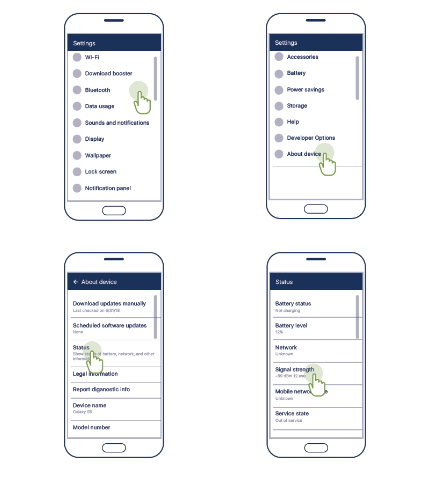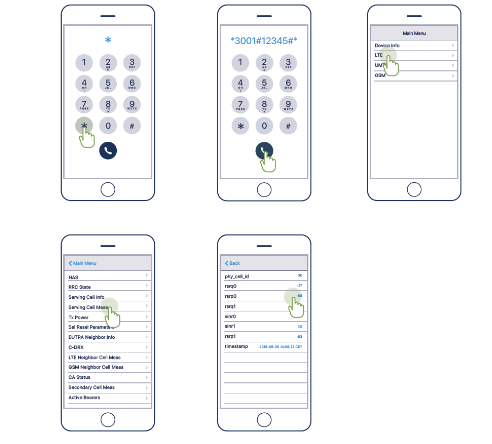A Fundamental Handbook on Cell Phone Signal.

Cellular signal serves as the link connecting users to one another through networks. In much the same way as two-way radios establish communication, a signal transmitter and receiver permit signal transmission to reach cell phones. During a phone call, the user’s voice converts into a signal, which is then transmitted through radio waves to the nearest cell tower. Subsequently, the cell tower forwards the radio wave to the intended recipient, converting it from a signal to sound. When cell signal strength is optimal, this process occurs seamlessly, and users don’t give it a second thought. However, weaker cell signals can result in dropped calls and delayed data transmissions
At present, over 95% of the population possess a mobile phone, with smartphones making up 77 percent of this ownership. In most cases, these phones function correctly, allowing users to make and receive calls and texts and to transfer and obtain data. Despite our dependence on cellular signal in our daily routines, the majority of us lack knowledge regarding its origin and functionality.

How is cell signal measured?
Cell phone signal strength is measured in decibels (dBm) that are received by a mobile phone from a cellular network. Signal strengths usually range from approximately -30 dBm to -110 dBm. The closer that number is to 0, the stronger the cell signal. Any signal that measures better than -85 dBm is considered to be a good cell phone signal strength.
Most mobile devices show a set of bars to display the signal strength that the device is receiving. In reality, however, those bars on your cell phone are not an accurate measure of signal strength.That’s because there is no industry standard for what a bar represents or whether it measures your 4G data or 3G voice performance. Therefore, two bars worth of coverage on Verizon’s network may be three bars on Sprint’s, for example. Aside from carrier differences, the number of bars you see can vary based on how you hold your phone, your phone manufacturer, and even previous activity on the device.
Using Field Test Mode
If you’re really curious about the signal your phone is receiving, determining the dBm on your own phone is a far more accurate measure of signal strength than relying on the number of bars displayed. Depending on your device, there are different ways to do this, including using the field test mode available on Android and Apple iOS devices.
Field Test Mode on iPhone gives users detailed information about their signal and cellular connection, and providers. Field Test Mode displays the cell signal on iPhones as a number rather than as signal bars or dots.
*Instructions may not work for iPhone’s using iOS 11 and higher.
To access Field Test Mode on an iPhone, it is necessary to have an active cellular connection. Once that requirement is met, the following steps should be followed:
1. Open the “Phone” app on your iPhone and enter the following number exactly: *3001#12345#*
2. Press the “Call” button to dial the number, which will launch the hidden “Field Test Mode” app on the iPhone.
3. Select “LTE” from the main menu
4. Select “Serving Cell Meas”
5. Find “rsrp0.” The corresponding number represents the numerical measurement of cellular signal strength in dBm

To use Field Test Mode for Android, follow these steps with an active cellular connection: Navigate to the phone’s menu (menu screen locations vary by phone manufacturer, model and Android OS version).
1. “About Phone”
2. “Status” or “Network”
3. “Signal Strength” or “Network Type and Strength.”
An alternate navigation to Field Test Mode for Android devices is:
1. “Settings”
2. “More Options,” or “More Settings”
3. “About Phone”
4. “Mobile Networks”
5. “Signal Strength”
For some older Android devices, navigating to Field Test Mode is as simple as:
1. “Open Settings”
2. “General”
3. “About Device”
4. Select “Status” to display signal strength in dBm

If you unable to determine your Android device’s signal strength reading by using any of these methods, check your device operations guide. There are also apps available from the Play Store, such as SignalCheck Lite, which may allow you to read your signal strength as well.
Remember, the closer your dBm number is to zero, the stronger your signal. For example, -100 would be a very poor signal and -50 would be a strong signal.
Cell signal is strongest when phones are in close proximity to cell towers. There are relatively few areas these days that don’t have some cell tower infrastructure close by; however, there are many environmental factors that can impede that cell signal from reaching your phone for a reliable connection.
What blocks cell signal?
You’ve likely experienced dropped calls, or have been in the midst of sending or receiving a message or document only to have progress come to a screeching halt. Maybe it happens when you’re driving through a tunnel, riding the subway, entering a parking garage, or stepping into an office building, but at one time or another, we all enter the dreaded “dead zone”. In fact, 72 percent of Americans complain of dropped calls, and 6 percent say they experience dropped calls several times a day, according to Pew Research.
So what blocks cell signal even in areas where there are plenty of cell towers and theoretically, an abundance of coverage? In short, many things. Cell signal can be impeded by natural environmental barriers, including mountainous terrain or thick forests and vegetation. Indoors, common building materials including brick, steel, concrete and LEED-certified glass windows can hamper a strong cell signal.
Furthermore, as the population of cell users increases, networks are becoming increasingly bogged down as devices compete for signal. That’s why you’ll most certainly experience a lag in service when you’re at a concert, a conference, or any other event where a large amount of people are using their cellular and mobile devices.
How can cell signal be improved?
If you have ever faced the annoyance of dropped calls or weak cell signal, it is likely that you have considered possible solutions to improve it. While many consumers are quick to attribute the issue to their network carrier and believe that switching to a different provider will solve the problem, the truth is that factors like the ones mentioned above can significantly impact cell signal strength, regardless of the carrier being used.
While some networks boast wider-spread and more reliable coverage, even the strongest network is no match for a building filled with concrete and brick, or a mountain highway blanketed in pine trees. The good news is that, thanks to cell signal boosting technologies, cell signal can be improved even in the largest areas.
How do cell phone signal boosters work?
As we get further into the 4G, LTE era, cell signal is improving overall. But there are still plenty of gaps in service that can occur based on all of the factors we’ve touched on in this article. Thanks to inventive technologies, however, there are ways to get the most out of the cell signal that is available. Cell phone booster systems offer scalable solutions suited for
settings ranging from residential homes to large worksites. The smallest apartment or the largest commercial building can benefit from this patented technology that captures and amplifies existing cell signal.
Cell phone signal boosters use a variety of antennas (depending on the location and need) to pick up signal from existing towers. Those signals are then electronically boosted and redistributed throughout the location via a network of smaller antennas. This captured signal is amplified within the location by as much as 32 times.
Because boosters can be installed zonally, there are many options for how and where signal can be improved. For example, more antennas will likely be necessary in a commercial cell phone booster configuration than in a residential one.
Comparison of Active and Passive Distributed Antenna Systems (DAS)
Cell phone signal boosters are either based on active or passive DAS technology. Active DAS creates cell coverage within a building by generating and distributing its own cell signal. Active DAS configurations require complex networks of fiber optics to be hardwired into a residential or commercial building. While this type of booster offers a robust and high-capacity cellular connectivity solution, the cost and infrastructure-intensive nature make it prohibitive for the majority of cellular service consumers.
Active DAS comprises hardware and installation that push the price point as high as $2-$4 per square foot for a single-carrier solution. If you’re looking for a multi-carrier solution, that price can go as high as $10 per square foot.

In contrast, passive DAS signal boosters offer a more feasible and affordable option for the majority of cellular consumers. By using existing cellular signals, installation is less invasive and much more affordable. Passive DAS solutions typically cost between 30 cents and 70 cents per square foot, inclusive of hardware and installation. Additionally, passive DAS solutions can benefit all users, regardless of their specific network carrier, making them carrier-agnostic.
Conducting a site survey
To select the appropriate antenna for a specific location, a site survey is necessary to identify areas with strong and weak signal. While many people use their cell phones to assess coverage in different locations, the bars displayed on a cell phone can be misleading in determining the actual strength of cell signals. Therefore, conducting a proper site survey is crucial for accurate assessment of signal strength.
A site survey is essential for identifying the source of the strongest cell signal and determining the optimal location for installing a donor antenna to maximize its effectiveness. The survey also provides information on the required amount of cable and accessories for the booster installation.
A proper site survey requires the use of a signal meter. This is handheld device used by professional installation experts to detect and displays signal frequency, bandwidth, and strength with total certainty.
Choosing the right antenna
Conducting a site survey is crucial in selecting the appropriate type of outdoor antenna, known as the “donor” antenna, to capture the signal that will be amplified inside. The donor antennas play a critical role in the amplifier system, primarily installed on the roof or near a window to capture the outdoor signal. Similarly, broadcast or “inside” antennas, such as panel antennas on interior walls or dome antennas on ceilings, are necessary to transmit the amplified signal to cellular devices indoors.
Two types of donor antennas include omnidirectional, or omni antennas, and directional, or Yagi antennas. Omni antennas are capable of capturing radiofrequency (RF) signals from any direction, while Yagi antennas, named after the Japanese engineer Hidetsugu Yagi, are highly directional and receive RF signals from a specific direction.
To determine which type of antenna will best boost the signal to a location, the installer will need to determine where the strongest signal is coming from and what may be interfering with that signal.
Benefits of cell signal boosters over Wi-Fi
Rewritten: In cases of cellular connection failure, many consumers turn to Wi-Fi as an alternative. However, the use of unsecured or even password-protected Wi-Fi networks can put uploaded or downloaded data at risk of data snooping or cyber-criminal attacks. Since Wi-Fi networks are inherently more vulnerable to such threats, it is important to invest in cell signal boosters that can improve signal strength while safeguarding your data. Furthermore, the strong cell signal that boosters provide can result in faster upload and download speeds than what can be achieved through Wi-Fi.
Carriers endorsing passive DAS
: Leading cellular network providers across the nation have moved away from network-specific solutions and are now promoting carrier-agnostic solutions that allow all users to leverage the existing infrastructure, regardless of their affiliation with Verizon, Sprint, AT&T, or T-Mobile.
The era of carrier-specific cell towers is coming to a close as major providers recognize the benefits of solutions that enhance cell signal for all users. In the past, carriers were wary of boosting solutions that could potentially disrupt entire networks. However, regulations mandated by the Federal Communications Commission in 2014 have established standards to prevent such occurrences.
WilsonPro, a leading provider of passive DAS cell signal boosting solutions, collaborated closely with the FCC to develop the guidelines that govern cell signal boosters today. These FCC regulations, along with advancements in passive DAS technology, have created a win-win situation for both carriers and customers.
And while 5G is still a ways off, carrier-agnosticism plays a key role in the progress towards the reality of a true 5G network.
Boosting cell signal where you need it
Whether you’re a homeowner looking to enhance cellular signal within your abode, or a building manager/owner seeking to improve signal for residents, WilsonPro can assist. We provide an array of passive DAS solutions that can be tailored to suit buildings and spaces of various sizes. Get in touch with us today to discover more about our offerings, and experience the advantages of dependable cellular connectivity.








